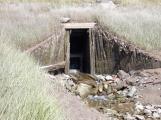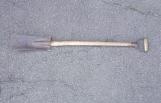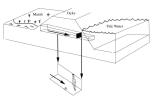1
An Acadian Heritage - The Dykes of Albert CountyVisitors to Albert County who drive along the banks of the Petitcodiac River and along the marshes at Shepody are being deceived by an optical illusion. What looks like the natural river bank or edge of the marsh lands is in fact an intricate drainage system first put in place by the early Acadian settlers and later maintained and expanded by the German and English settlers.
The dykes or "Aboiteau" (sluice gate) are used to reclaim much of this fertile marshland for farming. Since the Bay of Fundy has very high tides in this area, averaging 40 feet, the Petitcodiac River changes from a small stream at low tide to massive river capable of supporting a substantial ship six hours later.
The dykes were constructed along the edge of the marsh grasslands to keep the salt water of the Bay from flooding up over the mud flats and onto the marsh lands. If the dykes were not in place then during the period of highest tides (spring & fall) the marsh lands would be flooded making them too dangerous for cattle to graze and unsuitable for farming. Additionally eventually the tides would erode the top soil off the marshlands and the marshlands would become more mud flats.
It took a team of eight men to build the dykes, first they would determine how much marshland was needed, then seek out an appropriate spot where the marsh was firm and begin construction. They also tried to select building sites near an area of special soil used to make sods, these sods would then be used to construct the sides of the dyke. Work had to be done at a period of low tides. First a trench or "key" was dug along the center of the new dyke. By replacing the loose muddy soil from this trench with firmly packed soil from the dyke, it prevented the dyke from washing away at the next high tide.
The base of the dyke would be built up several feet in the air, with sloping sides. A special dyking spade was used to dig brick shaped blocks of marsh soil called sods.
3
The sods were cut in such a way that the grass was naturally at a thirty degree angle. Sods were made of a particular type of marsh and would be placed on the sloped sides of the dyke. These sods cut from the tough marsh grass; would keep the sides of the dyke from washing away until the roots of the sods would tangle and grow together. Eventually as these sods would grow together they would not only strengthen the sides of the dyke preventing future erosion from the high tides but would also make it appear as if the dyke were a natural occurrence, hence the optical illusion. A second trench was built on each side of the dyke, called the "borrow" pit, the soil from which formed part of the dyke itself.5
Sometimes the dyke, especially if it was very exposed to erosion, would have brush or planks added to the tide sides of the dyke to give it added stability. This is often seen in Dutch dykes facing the North Sea.While the men from several family farms would work together to build the aboiteau and the dykes around it, it was the responsibility of each farm family to maintain its own area of reclaimed marshland. The men with marshland along a segment of river would get together when more dyking was requested, to listen to the reasoning of the complainant. If the man was convincing, or the problem obvious, it would be approved and the men went to work as a team. Once the dyke was built a track would be added on top and ramps up to it would be built so that farm carts could move along the track.
6
A group of men constructing an Aboiteau on the Shepody Marsh.19 September 1870
Shepody Marsh, New Brunswick, Canada
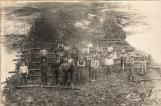
7
A group of men, oxen and horses constructing an Aboiteau.19 September 1870
Shepody Marsh, New Brunswick, Canada
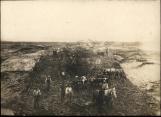
8
Tide water rushing over an Aboiteau which is under construction.19 September 1870
Shepody Marsh, New Brunswick, Canada
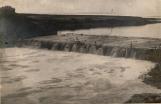
9
A group of men, oxen and horses constructing an Aboiteau using mud, logs and brush.19 September 1870
Shepody Marsh, New Brunswick, Canada
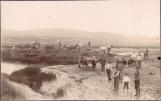
10
The remains of an original aboiteau from the nineteenth century.15 September 1870
Shepody Marsh, New Brunswick, Canada
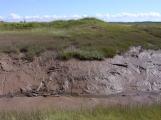
11
The aboiteau was a specially designed section of the dyke which would allow water from streams or rivers to flow out into the Bay but prevent tide water from flowing through the aboiteau and onto the marsh. The aboiteau was constructed with a square pipe up to five feet wide, made of thick planks, running from the stream on the marsh side of the dyke through the base of the aboiteau and out into the Bay. Inside the pipe is a gate which swings out to allow the stream water to escape, but is shut closed by the force of the tide water rushing into the pipe. The gate is blocked and therefore cannot swing inward.13
This design is still used today in some modern dykes.14
This photo shows the Bay side of a modern aboiteau.15 September 1940
Shepody Marsh, New Brunswick, Canada
